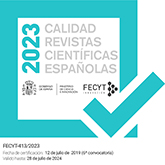Use of geometric morphometrics to identify ecophenotypic variation of juvenile Persian sturgeon Acipenser persicus
DOI:
https://doi.org/10.3989/scimar.04487.01AKeywords:
geometric morphometric selection, phenotypic plasticity, discrimination, habitatAbstract
Study of phenotypic variation is essential for identifying discrete phenotypic stocks. We sampled immature Persian sturgeon from the eastern and western portion of the southern Caspian Sea to test for morphological differences that could predict the ecophenotypic variation of Persian sturgeon. Geometric morphometric methods were used to quantify body shape. Configuration of landmark coordinates of fish body were scaled, translated and rotated using generalized Procrustes analysis, followed by univariate analysis of variance of resulting shape coordinates to evaluate potential morphological differences between regions. A principal component analysis was carried out to reduce the number of dimensions without the loss of information. The discriminate function analysis was performed to determine the efficacy of body landmarks for discrimination by geographic variants. Within-group linkage was inferred for dendrogram clusters using Pearson correlation distance on the basis of the average linkage method as a complement for discriminate analysis. Principle component analysis revealed that the largest differences were in body size. Most notable were differences in distance between head landmarks and the dorsal fin between eastern and western regions. Fish from the western region exhibited a longer distance from head landmarks to the dorsal fin than fish from the eastern region. Furthermore, the ventral portion of fish from the western region was longer than that of the eastern individuals. These findings show that juvenile Persian sturgeon already possess morphological traits that can be used to discriminate fish from different regions. Furthermore, these differences are discernible in spite of the volume of artificially-inseminated sturgeon larva that have been released during the past 40 years.
Downloads
References
Abdolhay H.A., Khalijah D.S., Pourkazemi M., et al. 2010. Morphometrics studies of Mahisefid (Rutilus frisii kutum, Kamensky, 1901) from selected rivers in the southern Caspian Sea. Iranian J. Fish. Sci. 9: 1-18.
Albertson R.C., Streelman J.T., Kocher T.D. 2003. Genetic basis of adaptive shape differences in the cichlid head. J. Hered. 94: 291-301. https://doi.org/10.1093/jhered/esg071 PMid:12920100
Bookstein F.L. 1997. Morphometric tools for landmark data: geometry and biology. Cambridge University Press.
Cadrin S.X. 2000. Advances in morphometric identification of fishery stocks. Rev. Fish Biol. Fish. 10: 91-112. https://doi.org/10.1023/A:1008939104413
Cadrin S.X. 2014. Morphometric landmarks, In: Cadrin S.X., Kerr L.A., Mariani S. (eds), Stock identification methods: Applications in fishery science. Academic Press. Elsevier, USA. pp. 109-124. https://doi.org/10.1016/B978-0-12-397003-9.00006-0
Cramon-Taubadel V., Ling E., Cotter D., et al. 2005. Determination of body shape variation in Irish hatchery-reared and wild Atlantic salmon. J. Fish Biol. 66: 1471-1482. https://doi.org/10.1111/j.0022-1112.2005.00698.x
Dumont H. 1998. The Caspian Lake: history, biota, structure, and function. Limnol Oceanogr. 43: 44-52. https://doi.org/10.4319/lo.1998.43.1.0044
Espinosa-Lemus V., Arredondo-Figueroa J.L., Barriga-Sosa I. 2009. Morphometric and genetic characterization of tilapia (Cichlidae: Tilapiini) stocks for effective fisheries management in two mexican reservoirs. Hidrobiológica 19: 95-107.
Favaloro E., Mazzola A. 2003. Shape change during the growth of sharpsnout seabream reared under different conditions in a fish farm of the southern Tyrrhenian Sea. Aquacult. Eng. 29: 57-63. https://doi.org/10.1016/S0144-8609(03)00050-5
Ginzburg A.I., Kostianoy A.G., Sheremet N.A. 2005. Sea surface temperature variability, The Caspian Sea Environment. Springer, pp. 59-81. https://doi.org/10.1007/698_5_004
Guenette S., Rassart E., Fortin R. 1992. Morphological differentiation of lake sturgeon (Acipenser fulvescens) from the St. Lawrence river and Lac des Deux Montagnes (Quebec, Canada). Canadian J. Fish. Aquat. Sci. 49: 1959-1965. https://doi.org/10.1139/f92-217
Hanson K., Hasler C., Suski C., et al. 2007. Morphological correlates of swimming activity in wild largemouth bass (Micropterus salmoides) in their natural environment. Comp. Biochem. Physiol. Part A: Mol. Integrat. Physiol. 148: 913-920. https://doi.org/10.1016/j.cbpa.2007.09.013 PMid:17977039
Hilton E.J., Schaefer S. 2002. Observations on rostral canal bones of two species of Acipenser (Actinopterygii, Acipenseriformes). Copeia 2002: 213-219. https://doi.org/10.1643/0045-8511(2002)002[0213:OORCBO]2.0.CO;2
Keenlyne K., Henry C., Tews A., et al. 1994. Morphometric comparisons of upper Missouri River sturgeons. Trans. Am. Fish. Soc. 123: 779-785. https://doi.org/10.1577/1548-8659(1994)123<0779:MCOUMR>2.3.CO;2
Khoshkholgh M., Pourkazemi M., Nazari S., et al. 2011. Genetic diversity in the Persian sturgeon, Acipenser percicus, from the south Caspian Sea based on mitochondrial DNA sequences of the control region. Caspian J. Env. Sci. 9: 17-25.
Kishida M., Kanaji Y., Xie S., et al. 2011. Ecomorphological dimorphism of juvenile Trachurus japonicus in Wakasa Bay, Japan. Environ. Biol. Fish. 90: 301-315. https://doi.org/10.1007/s10641-010-9743-5
Langerhans R.B., Reznick D.N. 2010. Ecology and evolution of swimming performance in fishes: predicting evolution with biomechanics. In: Domenici P., Kapoor B.G. (eds), Fish locomotion: an eco-ethological perspective. Science Publishers, Enfield, NH, USA, pp. 200-248. https://doi.org/10.1201/b10190-8
Mazlomi M., Hoseinzadeh Sahafi H., Salavatian M., et al. 2009. Recognation the existent status of restocking programs in the Caspian Sea, Iranian Fisheries Research Organization, Tehran, 284 pp.
Michel M.J., Chevin L.M., Knouft J.H. 2014. Evolution of phenotype–environment associations by genetic responses to selection and phenotypic plasticity in a temporally autocorrelated environment. Evolution 68: 1374-1384. https://doi.org/10.1111/evo.12371 PMid:24475940
Mirzajani A., Ghaninezhad D., Ghane S.S.A. 2005. The relation between fish catches values and macrobenthic biomass in Caspian Sea of Guilan province. Pajouhesh va Sazandegi. 18: 2-9.
Moghim M., Kor D., Tavakolieshkalak M., et al. 2006. Stock status of Persian Sturgeon (Acipenser persicus Borodin, 1897) along the Iranian coast of the Caspian Sea. J. Appl. Ichthyol. 22: 99-107. https://doi.org/10.1111/j.1439-0426.2007.00935.x
Monet G., Uyanik A., Champigneulle A. 2006. Geometric morphometrics reveals sexual and genotypic dimorphisms in the brown trout. Aquat. Living Res. 19: 47-57. https://doi.org/10.1051/alr:2006004
Motta P.J., Norton S.F., Luczkovich J.J. 1995. Perspectives on the ecomorphology of bony fishes. Environ. Biol. Fish. 44: 11-20. https://doi.org/10.1007/BF00005904
Pakkasmaa S., Piironen J. 2001. Morphological differentiation among local trout (Salmo trutta) populations. Biol. J. Linnean Soc. 72: 231-239. https://doi.org/10.1111/j.1095-8312.2001.tb01313.x
Quinn G.P., Keough M.J. 2002. Experimental design and data analysis for biologists. Cambridge University Press. https://doi.org/10.1017/CBO9780511806384
Rohlf F. 2006. tpsDig2, Version 2.1. State University of New York, Stony Brook.
Ruban G. 1989. Clinal variation of morphological characters in the Siberian sturgeon, Acipenser baeri, of the Lena basin. J. Ichthyol. 29: 48-55.
Ruban G., Sokolov L. 1986. Morphological variability of Siberian sturgeon, Acipenser baeri, in the Lena River in relation with its culture in warm waters. J. Ichthyol. 26: 88.
Russo T., Costa C., Cataudella S. 2007. Correspondence between shape and feeding habit changes throughout ontogeny of gilthead sea bream Sparus aurata L., 1758. J. Fish Biol. 71: 629-656. https://doi.org/10.1111/j.1095-8649.2007.01528.x
Russo T., Pulcini D., O'Leary A., et al. 2008. Relationship between body shape and trophic niche segregation in two closely related sympatric fishes. J. Fish Biol. 73: 809-828. https://doi.org/10.1111/j.1095-8649.2008.01964.x
Russo T., Pulcini D., Bruner E., et al. 2009. Shape and size variation: growth and development of the dusky grouper (Epinephelus marginatus Lowe, 1834). J. Morphol. 270: 83-96. https://doi.org/10.1002/jmor.10674 PMid:18798248
Russo T., Pulcini D., Costantini D., et al. 2012. "Right" or "wrong"? insights into the ecology of sidedness in european flounder, Platichthys flesus. J. Morphol. 273: 337-346. https://doi.org/10.1002/jmor.11027 PMid:22025394
Sheehan T.F., Kocik J.F., Cadrin S.X., et al. 2005. Marine growth and morphometrics for three populations of Atlantic salmon from eastern Maine, USA. Trans. Am. Fish. Soc. 134: 775-788. https://doi.org/10.1577/T04-067.1
Taft N.K. 2011. Functional implications of variation in pectoral fin ray morphology between fishes with different patterns of pectoral fin use. J. Morphol. 272: 1144-1152. https://doi.org/10.1002/jmor.10970 PMid:21626534
Tancioni L., Russo T., Cataudella S., et al. 2013. Testing species delimitations in four Italian sympatric leuciscine fishes in the Tiber River: a combined morphological and molecular approach. PLoS One 8: e60392. https://doi.org/10.1371/journal.pone.0060392 PMid:23565240 PMCid:PMC3614999
Tavakoli M., Khoshghalb M.R., Hadadi Moghadam K., et al. 2009. Stock assessment of sturgeon fish in the south Caspian Sea, Iranian Fisheries Research Organization, Tehran. 129.
Toscano B.J., Pulcini D., Hayden B., et al. 2010. An ecomorphological framework for the coexistence of two cyprinid fish and their hybrids in a novel environment. Biol. J. Linnean Soc. 99: 768-783. https://doi.org/10.1111/j.1095-8312.2010.01383.x
Vasil'eva E.D. 2009. Morphological and morphometric characters in sturgeon taxonomy and phylogeny, Biology, Conservation and Sustainable Development of Sturgeons. Springer, pp. 51-61. https://doi.org/10.1007/978-1-4020-8437-9_3
Vecsei P., Peterson D. 2005. Sturgeon ecomorphology: a descriptive approach. Sturgeons and Paddlefish of North America. Springer, pp. 103-133. https://doi.org/10.1007/1-4020-2833-4_6
Walsh M.G., Bain M.B., Squiers T., et al. 2001. Morphological and genetic variation among shortnose sturgeon Acipenser brevirostrum from adjacent and distant rivers. Estuaries 24: 41-48. https://doi.org/10.2307/1352811
Wessel M.L., Smoker W.W., Joyce J.E. 2006. Variation of morphology among juvenile Chinook salmon of hatchery, hybrid, and wild origin. Trans. Am. Fish. Soc. 135: 333-340. https://doi.org/10.1577/T04-078.1
Wintzer A., Motta P. 2005. Diet-induced phenotypic plasticity in the skull morphology of hatchery-reared Florida largemouth bass, Micropterus salmoides floridanus. Ecol. Freshwat. Fish 14: 311-318. https://doi.org/10.1111/j.1600-0633.2005.00105.x
Zar J. 1996. Biostatistical Analysis, 3rd ed., Prentice Hall, New Jersey.
Zelditch M.L., Swiderski D.L., Sheets H.D. 2012. Geometric morphometrics for biologists: a primer. Academic Press.Abdolhay H.A., Khalijah D.S., Pourkazemi M., et al. 2010. Morphometrics studies of Mahisefid (Rutilus frisii kutum, Kamensky, 1901) from selected rivers in the southern Caspian Sea. Iranian J. Fish. Sci. 9: 1-18.
Published
How to Cite
Issue
Section
License
Copyright (c) 2017 Consejo Superior de Investigaciones Científicas (CSIC)

This work is licensed under a Creative Commons Attribution 4.0 International License.
© CSIC. Manuscripts published in both the printed and online versions of this Journal are the property of Consejo Superior de Investigaciones Científicas, and quoting this source is a requirement for any partial or full reproduction.All contents of this electronic edition, except where otherwise noted, are distributed under a “Creative Commons Attribution 4.0 International” (CC BY 4.0) License. You may read here the basic information and the legal text of the license. The indication of the CC BY 4.0 License must be expressly stated in this way when necessary.
Self-archiving in repositories, personal webpages or similar, of any version other than the published by the Editor, is not allowed.














